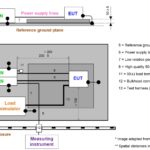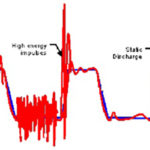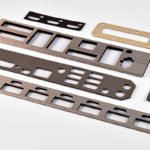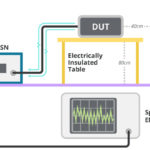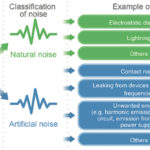By Timothy Hegarty, Applications Engineer, Texas Instruments
This article compares electromagnetic compatibility (EMC) requirements in automotive, industrial and defense product family standards, specifically various test parameters, test equipment, test setups and test methods for radiated emissions (REs). Much like the treatment of conducted emissions [1] in part 1 of this two-part article series, the comparison includes widely used EMC standards in each industry [2-4]: Comité International Spécial des Perturbations Radioélectriques (CISPR) 25 edition 4 from 2016, a product standard for the protection of onboard receivers in vehicles, boats and internal combustion engines [5]; CISPR 11 edition 6 from 2015, a product standard for industrial, scientific and medical (ISM) equipment [6]; and military standard MIL-STD-461 revision G from 2015, a defense standard for equipment and subsystems enclosures [7-8]. CISPR has subcommittees B and D responsible for CISPR 11 and 25, respectively, whereas the U.S. Department of Defense maintains MIL-STD-461.
RE test setups and methods
A. Applicability and test frequency ranges
Components and modules intended for onboard automotive applications are tested according to CISPR 25 over a total frequency range of 150 kHz to 2.5 GHz.
Testing in CISPR bands C and D over a frequency range of 30 MHz to 1 GHz in accordance with the scope of CISPR 11 fulfills RE requirements for products manufactured in ISM applications. As outlined in a later section, the applicability of the tests in CISPR 11 depends on the equipment’s intended installation environment.
In MIL-STD-461G, carrying out RE101 (magnetic field) and RE102 (electric field) tests in the frequency range of 30 Hz to 100 kHz and 10 kHz to 18 GHz, respectively, fulfills RE requirements. These test procedures verify that magnetic and electric field emissions from the equipment under test (EUT) and its associated cabling do not exceed specified requirements.
B. Test equipment
The primary test equipment required to conduct RE tests includes:
- An EMI receiver or spectrum analyzer – with the appropriate peak (PK), quasi-peak (QP) or average (AV) detector as defined in CISPR 16-1-1.
- A line impedance stabilization network (LISN) or artificial network (AN) – as detailed extensively in part 1 – that provides a definite and constant impedance (close to 50 Ω) across the EUT power terminals over the applicable test frequency range.
- Several antennas – including a magnetic field probe for RE101, a monopole rod antenna for RE102 and CISPR 25, and biconical and double-ridge guide horn antennas for RE102, CISPR 11 and CISPR 25 tests.
Table 1 details the applicable frequency ranges for different applications. The table includes a comparison of various test parameters such as test frequency range, LISN network type, test equipment and test setup requirements.
The measurement receiver should be able to sweep the required test frequency range with the appropriate resolution bandwidth (RBW) provided in the respective standards for different applications. To that end, Table 2 gives the EMI receiver settings, including detector type, RBW, measurement step size and dwell-time parameters.
Note that CISPR 25 describes three RE measurement techniques: the absorber-lined shielded enclosure (ALSE) method, the transverse electromagnetic (TEM) cell method and the stripline method. This article only discusses the ALSE method, as it facilitates measurement up to 2.5 GHz.
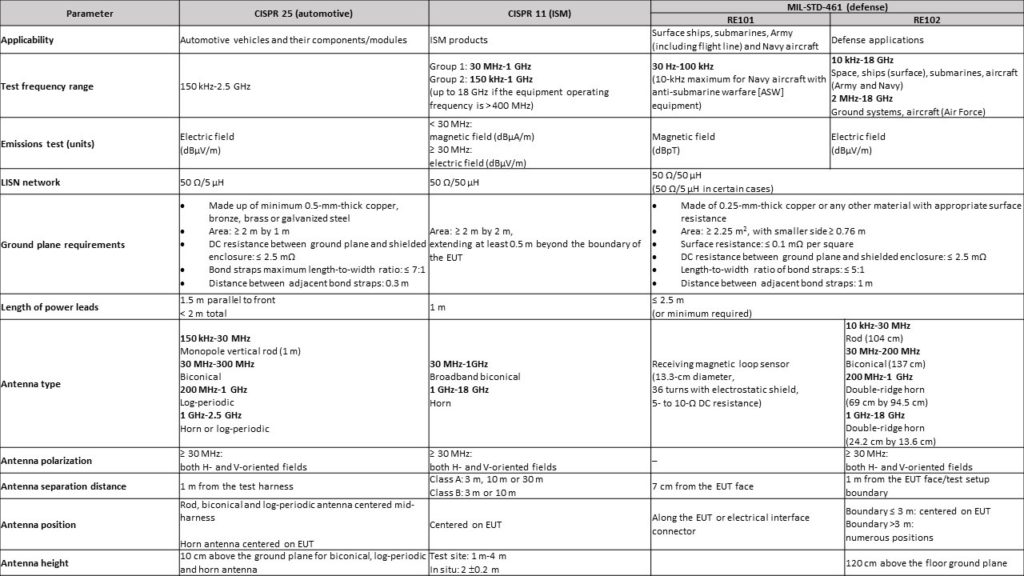

C. Test setup requirements
- Antenna types
As outlined in Table 1, CISPR 25 specifies linearly polarized rod, log-periodic, biconical and horn (electric field) antennas with a nominal 50-Ω output impedance to cover a range of frequencies from 150 kHz to 2.5 GHz. CISPR 11 uses broadband biconical and horn antennas [9] to detect RE disturbances from 30 MHz to as high as 18 GHz. MIL-STD-461 uses a magnetic field loop sensor for RE101 from 30 Hz to 100 kHz, and rod, biconical and horn antennas for RE102 from 10 kHz to 18 GHz. Specifications above 30 MHz generally require measurements with both horizontal and vertical antenna polarizations.
- Antenna distances
Both CISPR 25 and MIL-STD-461 RE102 specify an antenna distance of 1 m, whereas CISPR 11 calls for 3 m, 10 m or 30 m depending on the test location (laboratory or in situ) and the equipment group and class designation. The MIL-STD-461 RE101 test is unique in that it requires a magnetic field measurement at frequencies as low as 30 Hz, with a loop antenna set 7 cm from the EUT. CISPR 11 also has a magnetic field measurement for group 2 equipment from 150 kHz to 30 MHz.
- Receiver detector types
CISPR 25 uses PK or QP and AV detectors. CISPR 11 uses QP and AV detectors, and MIL-STD-461 calls for a PK detector to carry out RE tests.
- Reference ground plane
Made of copper, brass, bronze or galvanized steel, the ground plane is the top metallic surface on the test bench/table and electrically bonds to the walls or the floor of the shielded enclosure such that its DC resistance does not exceed 2.5 mΩ. The minimum sizes of the ground plane for RE measurements are specified as 2 m by 1 m, 2 m by 2 m and 2.25 m2 according to the CISPR 25, CISPR 11 and MIL-STD-461 publications, respectively
- EUT and LISN placement
The EUT for CISPR 25 mounts on a nonconductive, low relative permittivity material (er ≤ 1.4), such as plastic foam or wood, to realize a height of 50 mm above the reference ground plane. The CISPR 11 table-mounted setup is 800 mm above the ground plane. The EUT should be bonded to the ground plane if it is bonded in the actual installation. The LISN mounts on the ground plane and bonds electrically to it.
- Placement and length of power cables
The power leads that run from the EUT to the LISN power port are placed over a nonconductive low relative permittivity (er ≤ 1.4) support material, at a height of (50 ±5) mm above the reference ground plane for CISPR 25 and MIL-STD-461. The 50-mm standoff standardizes loop areas available for coupling and parasitic capacitances from switching nodes to the ground plane.
For MIL-STD-461, the first 2 m of each interconnecting cable associated with each enclosure of the EUT routed parallel to the front boundary of the setup ensures that RE testing properly assesses the performance of the EUT.
The lengths of the power leads are 1.5 m, 1 m and 2 m, as defined by the CISPR 25, CISPR 11 and MIL-STD-461 publications, respectively.
RE limits and test setups
- CISPR 25
Figure 1 shows the CISPR 25 Class 5 PK and AV limits for REs using the ALSE method. Since the mounting location, vehicle body construction and harness design can affect the coupling of RE disturbances to onboard radio receivers, CISPR 25 delineates multiple limit levels, with Class 5 being the most stringent. Classes 4, 3, 2 and 1 have 6- to 10-dB progressively higher limits.
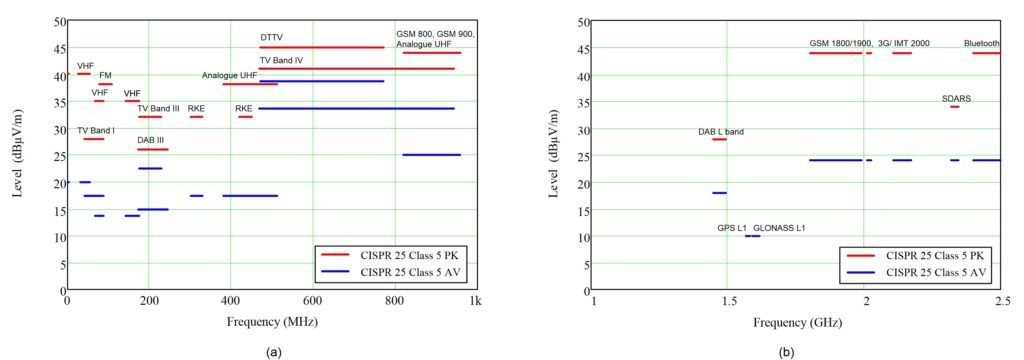
Figures 2, 3 and 4 depict the RE test setups over various frequency ranges recommended by CISPR 25, showing top, front and side views. This standard defines the disposition of the system under test and the measurement protocols and equipment. The AN(s) are mounted directly on the reference ground plane, with the AN case(s) bonded to the ground plane. The power-supply return also connects to the ground plane between the power supply and the AN. Each AN has a 50-Ω termination at its measurement port.
The measurement antenna is placed at 1 m. The phase center of the antenna aligns with the center of the longitudinal part of the wiring harness for frequencies up to 1 GHz and in line with the EUT for frequencies above 1 GHz.
The shielded harness used for this test is representative of the vehicle application in terms of cable construction and connector termination, as defined in the test plan.
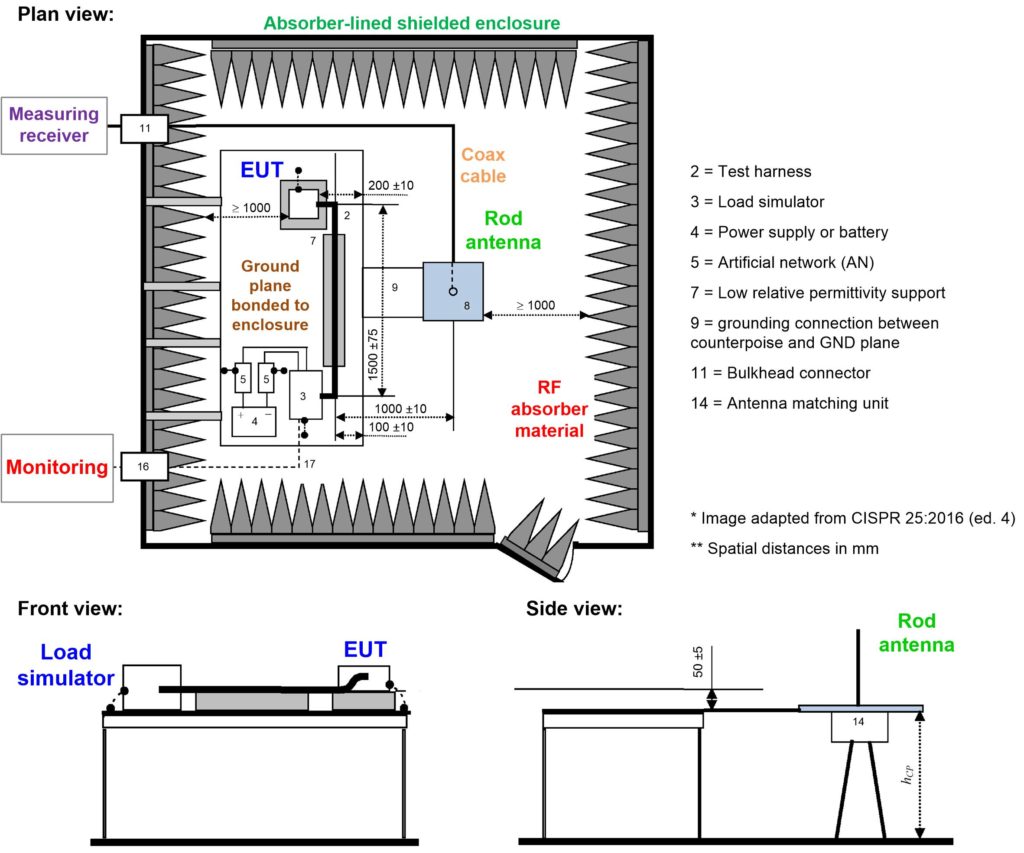
 Figure 3: CISPR 25 radiated EMI test setup with biconical/log-periodic antenna, 30 MHz to 1 GHz.
Figure 3: CISPR 25 radiated EMI test setup with biconical/log-periodic antenna, 30 MHz to 1 GHz.
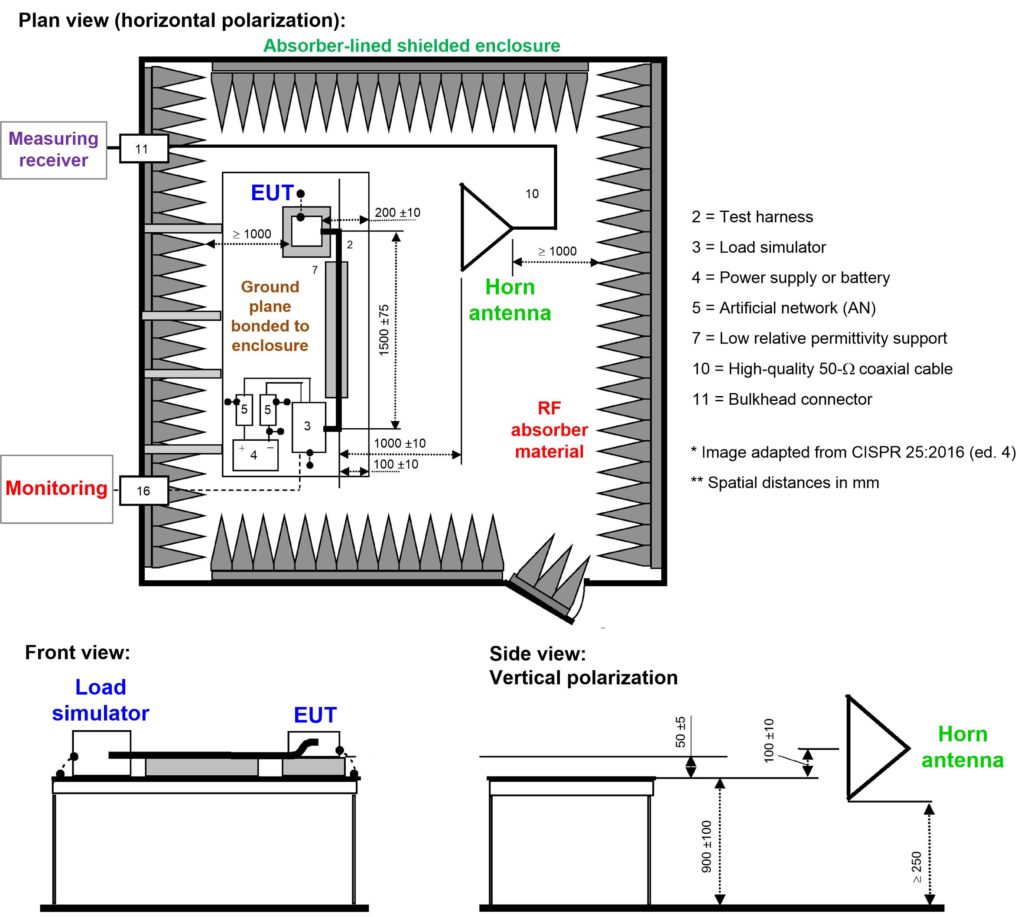
- CISPR 11
CISPR 11 is concerned with the control of RF disturbances from ISM equipment by assessing these disturbances either at a standardized test site or, for an individual ISM radio-frequency (RF) application that cannot be tested at such a site, at its place of operation (in situ).
CISPR 11 categorizes equipment into one of two groups: group 2 is for all ISM RF equipment in which RF energy is intentionally generated and used locally, whereas group 1 equipment contains all equipment in the scope of CISPR 11 that is not classified as group 2.
Group 1 equipment covers the frequency range of 30 MHz to 1 GHz, while group 2 equipment spans 150 kHz to 1 GHz (and up to 18 GHz if the equipment’s operating frequency is above 400 MHz). The limits below 30 MHz for group 2 Class A refer to the magnetic field strength component measured in decibel microamperes per meter. Above 30 MHz corresponds to the classic electric field strength measurement in decibel microvolts per meter.
Each equipment group has Class A (nonresidential, industrial, commercial) and Class B (residential, consumer) designations with relevant limits. Because Class B limits cover residential environments where products are more likely to be within close proximity to one another (within 10 m of broadcast radio and television receivers), they are more strenuous in order to avoid interference issues.
Figure 5 shows the CISPR 11 limit lines for group 1 and group 2 equipment at a test site using a QP detector. The antenna distance is 10 m, except for group 2 Class B magnetic field measurements, where it is 3 m. See Tables 7 and 8 (group 1) and Tables 10 to 15 (group 2) of the CISPR 11 publication for additional context. Limits are also available for equipment measured in situ – see Tables 16 and 17 of CISPR 11 for group 1 Class A and group 2 Class A, respectively.
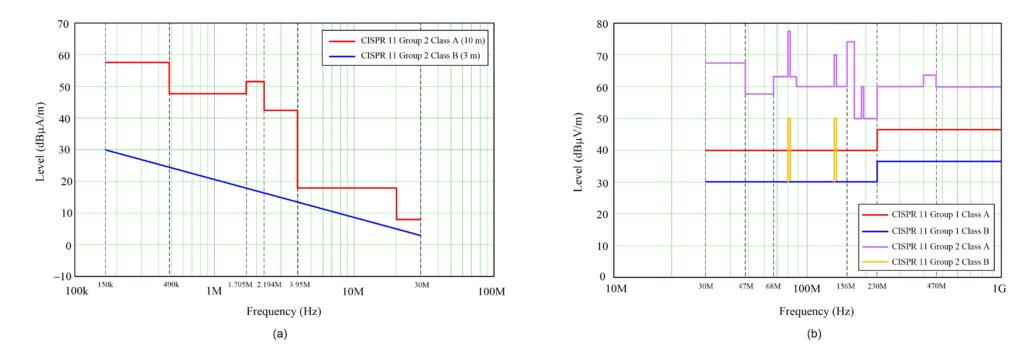
Class A equipment may be measured on a standardized test site (laboratory) or at its place of operation (in situ), depending on the manufacturer’s preference. Class B equipment is measured only on a test site. Class A equipment at a test site uses a nominal antenna distance of 3 m, 10 m or 30 m (and while test limits are not specified for group 1 equipment at a separation distance of 30 m, an inverse proportionality factor of 20 dB per decade applies to normalize the measured data to the specified distance for determining compliance). Class B equipment uses a distance of 3 m or 10 m.
In the frequency range of 30 MHz to 1 GHz, a measuring distance of 3 m is allowed for small-size equipment that fits within a cylindrical test volume 1.2 m in diameter and 1.5 m in height above ground. Figure 6 shows such an arrangement for a bench-mounted EUT [10] centered on the turntable’s vertical axis. Peripheral equipment not fitting into the test volume is omitted from the measurements or decoupled from the test environment.
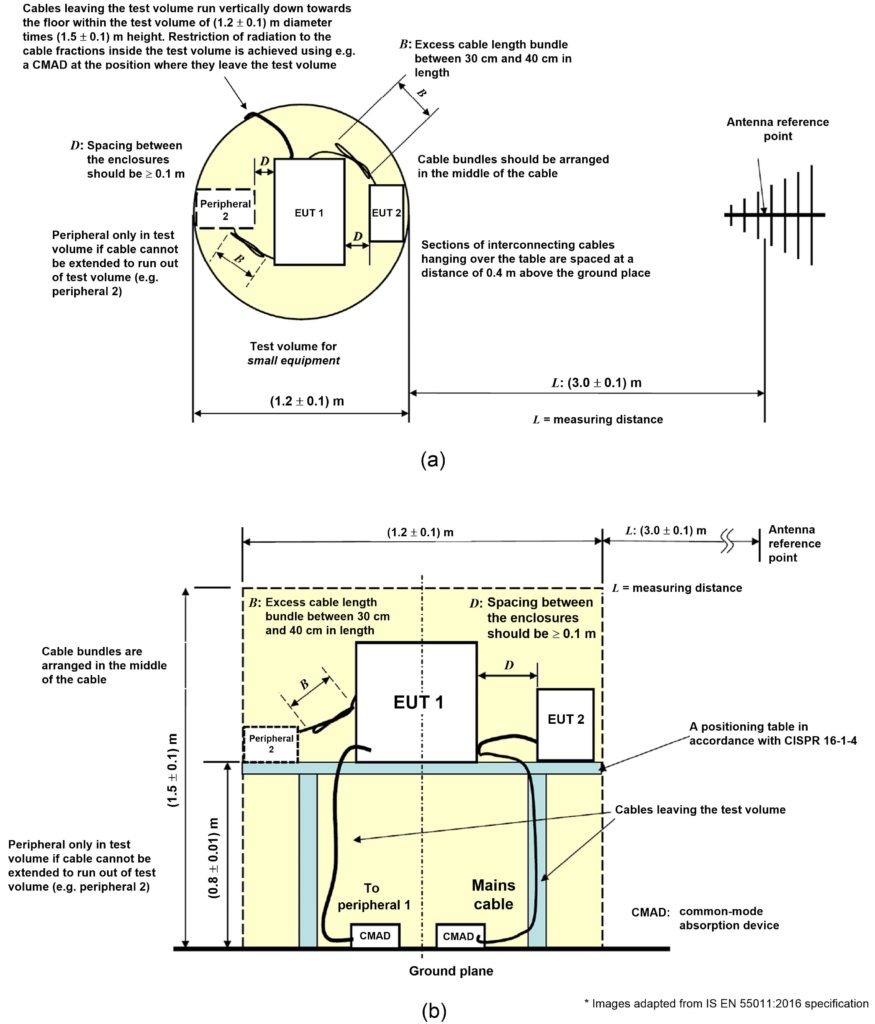
At a test site, the antenna must be raised and lowered from 1 m to 4 m in the frequency range of 30 MHz to 1 GHz. For measuring products in situ, the antenna’s center is fixed 2 m above ground. Figure 7 depicts a typical unified test setup for floor-standing equipment [10] suitable for the measurement of radiated (and conducted) disturbances. It shows the placement of the EUT, associated equipment (AE), common-mode absorption devices (CMADs) and artificial mains networks (AMNs).
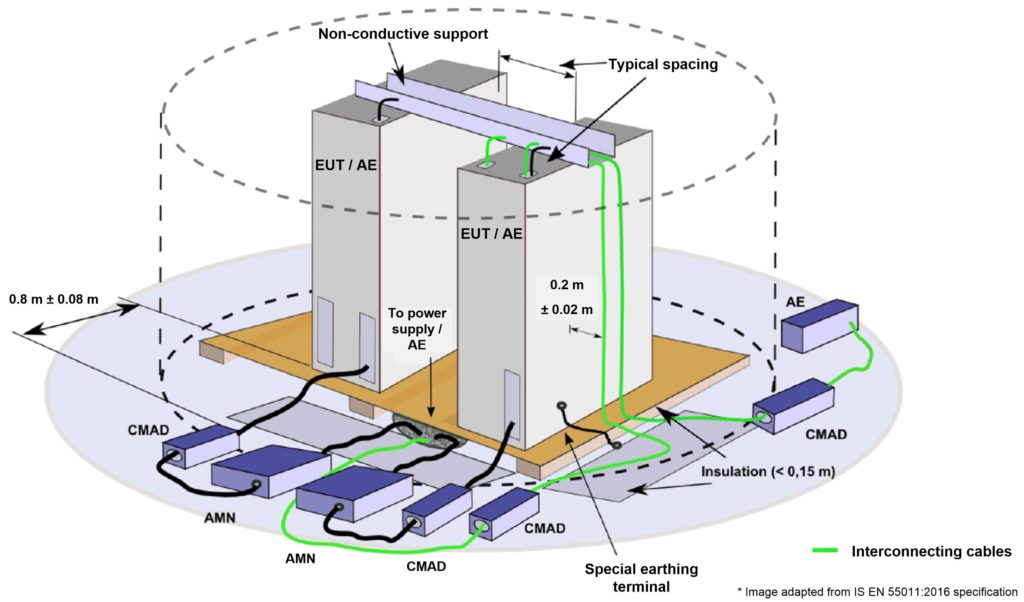
For measurements at a test site, the center of the antenna varies between 1 m and 4 m in height for maximum indication at each test frequency. For in-situ measurements, the center of the antenna is fixed at a 2-m height above ground.
- MIL-STD-461 (RE101 and RE102)
The RE101 test is quite specialized and is designed to control magnetic fields from 30 Hz to 100 kHz for applications where equipment is present in an installation that is possibly sensitive to magnetic induction at lower frequencies. Magnetic fields act by inducing voltages into loop areas in accordance with Faraday’s law, . For a uniform magnetic field perpendicular to the loop area, the induced voltage from Faraday’s law reduces to .
For Navy aircraft in particular, the requirement applies to installations using ASW equipment, specifically equipment in the same cabinet or avionics bay, or equipment that shares the same power bus or cable bundles as ASW equipment. The primary concern is possible effects to low-frequency acoustic systems and sensors, and low-frequency communications systems with sensitivities in the nanovolt range. The Navy RE101 limit is based on preventing the induction of more than 0.5 μV (nominal) on an RG-264A/U transmission line (with a loop area of 4.2 cm2), with a maximum induced level of 4 μV at 60 Hz. Meanwhile, the higher Army RE101 limit is based on preventing the induction of more than 2.5 mV in a 12.7-cm (5-inch) diameter loop. Since magnetic induction is proportional to frequency and the limit falls off at 20 dB per decade, the induced voltage in a given loop area is constant.
The RE102 test is designed to control electric field emissions from 10 kHz to 18 GHz and is mainly concerned with possible effects with antenna-connected receivers. These categories apply:
- Surface ship applications with limits defined for above deck and exposed below deck, and for below deck.
- Submarine applications with limits defined for internal to pressure hull and external to pressure hull.
- Aircraft and space system applications with limits defined for fixed-wing internal, greater than 25 m nose to tail; fixed-wing internal, less than 25 m nose to tail; and fixed-wing external and helicopters. Fixed-wing limits begin at 2 MHz instead of 10 kHz.
- Ground applications with limits defined for Navy fixed and Air Force, and Navy mobile and Army.
Figures 8 and 9 show the MIL-STD-461 limits for the RE101 (magnetic field in decibels relative to one pico-Tesla) and RE102 (electric field in decibel microvolts per meter) tests, respectively.
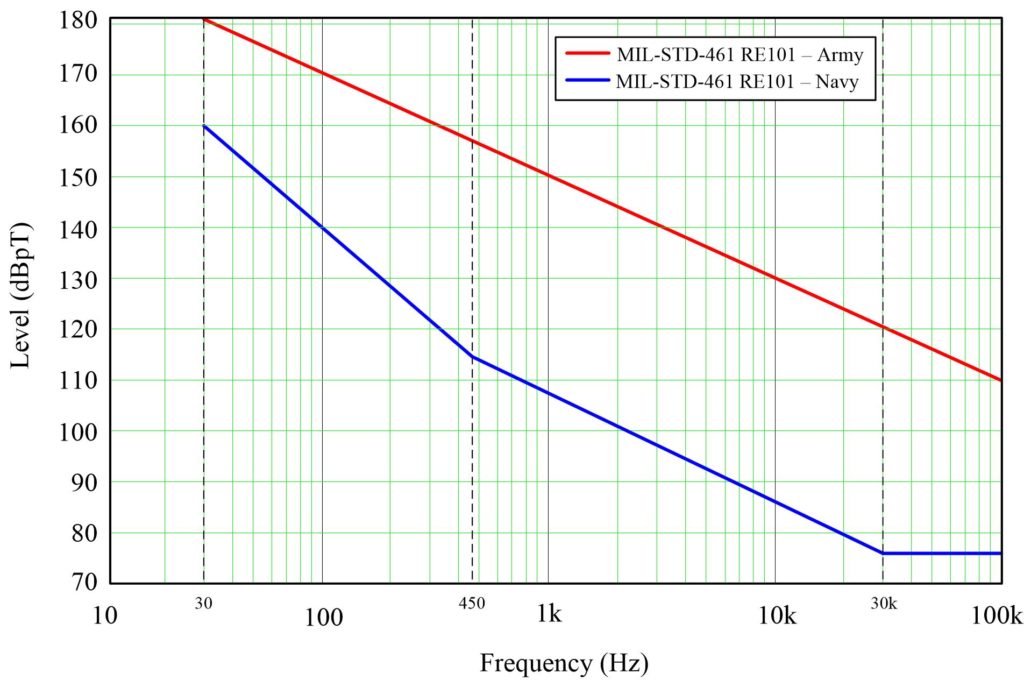
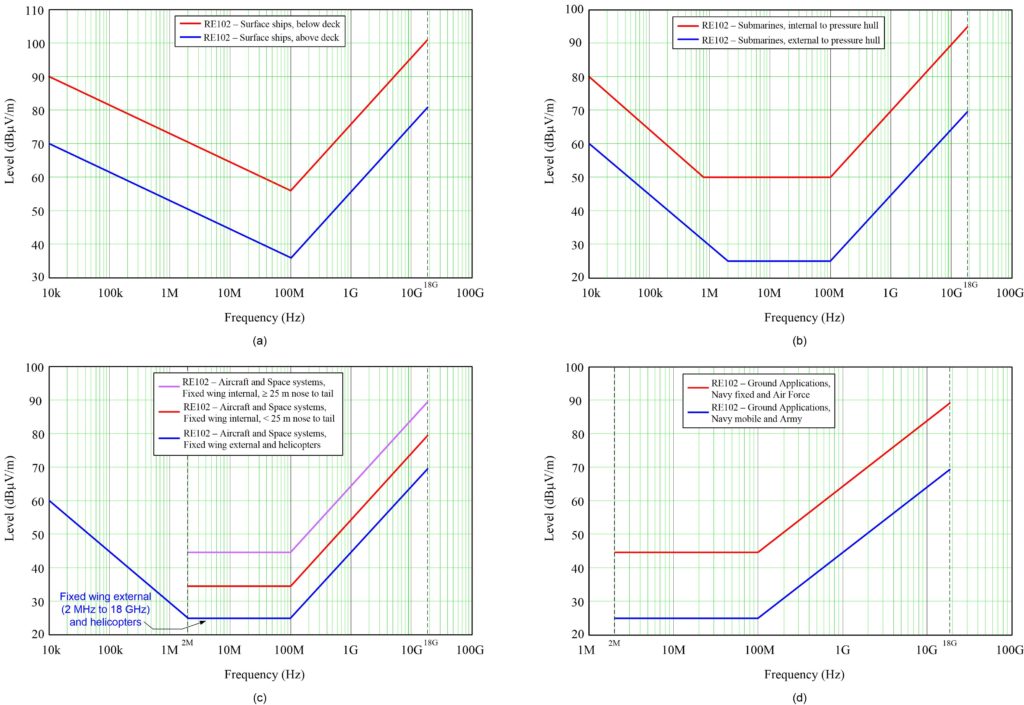
Figure 10 depicts one of the typical test setups for both RE101 and RE102 tests in MIL-STD-461. The setup is the same as that for the CE101 and CE102 tests detailed in part 1 [1]. The input power leads are at least 2 m in length (including neutrals and returns) and routed parallel to the front edge of the setup. Each input power lead connects to a LISN. All power leads are supported 5 cm above the ground plane with nonconductive material (foam or wood). The total power lead length from the EUT electrical connector to the LISNs should not exceed 2.5 m – except for large EUTs where the cables are routed from the top of a tall EUT or from the bottom of a floor-standing cabinet. In that case the total length may then exceed 2.5 m, but is still kept to a minimum.
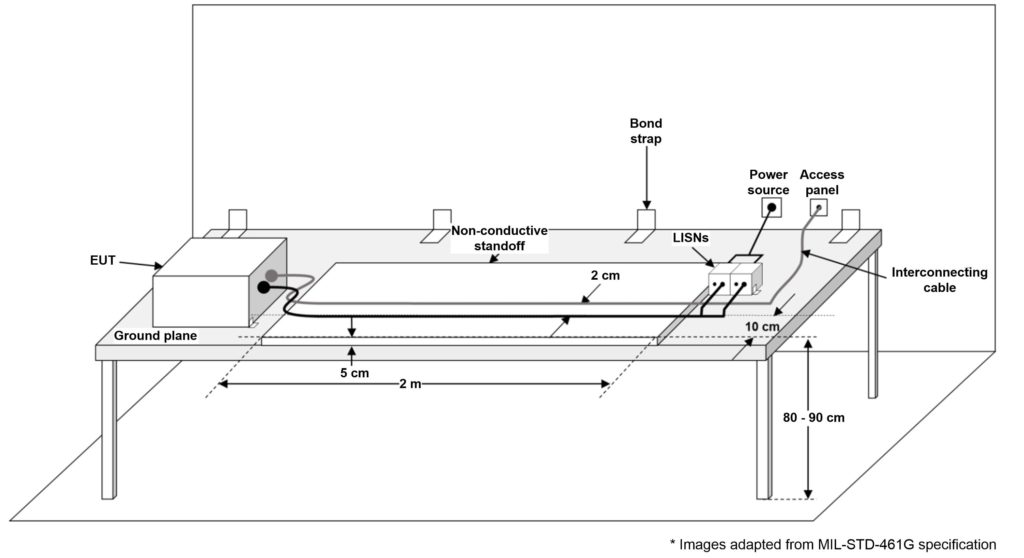
As shown in Figure 11a for the RE101 measurement, set the magnetic field probe 7 cm from the EUT. And as shown in Figure 11b and 11c for the RE102 test, set antennas 1 m from the front edge of the test setup boundary for all setups.
All of the specified antennas are linearly polarized. Above 30 MHz, measurements will measure both horizontal and vertical components of the radiated field. Measurements with the rod antenna are performed only for vertical polarization, as this antenna configuration is not readily adaptable to horizontal measurements.

Note how the monopole rod antenna setup in Figure 11b is configured with a ferrite sleeve clamped around the coaxial line between the rod antenna base and the EMI receiver [8]. This detunes an observed resonance that occurs between 20 MHz and 30 MHz. The relevant feature of the sleeve is that its impedance is mainly resistive/absorptive in the frequency range of interest, as is appropriate for detuning a resonance. The ferrite sleeve has an impedance of 20 Ω to 30 Ω (lossy with minimal inductance) at 20 MHz and is located near the center of the coaxial cable length between the antenna-matching network and the floor.
Summary
This article explained the similarities and differences in various EMC test parameters, test equipment, test setups and test methods for RE testing within the purview of CISPR 25, CISPR 11 and MIL-STD-461 for automotive, industrial and defense applications, respectively. The MIL-STD-461 defense standard is harmonized to an extent with its commercial counterparts, such as CISPR 11 and CISPR 25.
References
- Hegarty, Timothy. 2021. “A comparison of EMI test setups and specifications for automotive, industrial and military use cases, part 1: conducted emissions.” April 2021.
- Hegarty, Timothy. 2018. “An overview of conducted EMI specifications for power supplies.” Texas Instruments white paper, literature No. SLYY136, February 2018.
- Hegarty, Timothy. 2021. “An engineer’s guide to EMI in DC-DC converters.” How2power.com.
- Chaluvadi, Mahesh, G. Vincentraj and K. George Thomas. “An insight into MIL-STD-461G: a study report.” Published in IEEE International Conference on Power, Control, Signals and Instrumentation Engineering, Sept. 21-22, 2017, pp. 1356-1359.
- “Vehicles, boats and internal combustion engines – Radio disturbance characteristics – Limits and methods of measurement for the protection of on-board receivers.” CISPR 25:2016, fourth edition (or EN 55025:2017). CISPR: Geneva, Switzerland, October 2017.
- “Industrial, scientific and medical equipment – Radio-frequency disturbance characteristics – Limits and methods of measurement.” CISPR 11:2015, sixth edition. CISPR: Geneva, Switzerland, January 2019.
- “Requirements for the control of electromagnetic interference characteristics of subsystems and equipment.” MIL-STD-461G, S. Department of Defense Interface Standard: Washington, DC, December 2015.
- Javor, Ken. 2016. “MIL-STD-461G: The ‘Compleat’ Review.” Interference Technology magazine, April 15, 2016.
- “Specification for radio disturbance and immunity measuring apparatus and methods – Part 1-2: Radio disturbance and immunity measuring apparatus – Coupling devices for conducted disturbance measurements.” CISPR 16-1-2:2014. CISPR: Geneva, Switzerland, August 2020.
- “Industrial, scientific and medical equipment – Radio-frequency disturbance characteristics – Limits and methods of measurement.” IS EN 55011:2016, European norm standard based on CISPR 11. European Committee for Electrotechnical Standardization (CENELEC): Brussels, Belgium, 2016.

